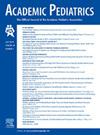Neighborhood-Level Social Determinants of Health and Adolescent Mental Health
IF 3
3区 医学
Q1 PEDIATRICS
引用次数: 0
Abstract
Objective
Mental health diagnoses among adolescents are increasing in prevalence. Existing literature considers associations between individual-level social determinants of health (SDOH) and adolescent mental health. Neighborhood-level SDOH can have a substantial impact on health. This paper examines associations between neighborhood-level SDOH and mental health diagnoses of anxiety, depression, and suicidal ideation among hospitalized adolescents.
Methods
We used 2018 and 2019 Texas Inpatient Discharge Public Use Data Files linked to the zip-code level Child Opportunity Index 2.0, a composite measure of subdomains which characterize neighborhood-level SDOH, to examine rates of mental health diagnoses and associations with patient characteristics across opportunity level quintiles.
Results
The sample included 50,011 adolescents ages 10–19 admitted to the hospital with the mental health diagnoses anxiety, depression, and/or suicide. Most had a single diagnosis; anxiety (12.9%), depression (37.5%), or suicide (13.0%). Hospitalized adolescents 10–14 years old were a plurality (44.2%) of the sample. Most adolescents were White (64.2%) and non-Hispanic (67.4%) and lived in rural areas (29.6%). Adolescents from racial minority populations and those in rural communities with mental health diagnoses had lower opportunity-levels. Higher opportunity levels were associated with greater odds of having an anxiety or suicide diagnosis while a depression diagnosis was associated with a lower opportunity-level.
Conclusions
There are significant differences in adolescent mental health diagnoses associated with neighborhood opportunity-level. While all adolescents can benefit from mental health education, screening, and early interventions, additional resources tailored to neighborhood-level opportunity may prove a more meaningful way to improve population-level mental health outcomes.
邻里层面的健康与青少年心理健康的社会决定因素。
目的:青少年心理健康诊断的发病率正在上升。现有文献考虑了个人层面的健康社会决定因素(SDOH)与青少年心理健康之间的关联。然而,邻里层面的 SDOH 也会对健康产生重大影响。本文研究了住院青少年中邻里层面的 SDOH 与焦虑、抑郁和自杀意念等心理健康诊断之间的关联:我们使用了 2018 年和 2019 年德克萨斯州住院病人出院公共使用数据文件,并将其与邮政编码级别的儿童机会指数 2.0 相链接,后者是描述邻里级别 SDOH 的子域的综合测量方法,用于研究不同机会级别五分位数的心理健康诊断率以及与患者特征之间的关联:样本包括 50,011 名 10-19 岁入院并被诊断为焦虑、抑郁和/或自杀的青少年。大多数人只有一种诊断:焦虑(12.9%)、抑郁(37.5%)或自杀(13.0%)。在样本中,住院的 10 至 14 岁青少年占大多数(44.2%)。大多数青少年为白人(64.2%)和非西班牙裔(67.4%),居住在农村地区(29.6%)。来自少数种族群体和农村社区的青少年被诊断出患有精神疾病的机会水平较低。较高的机会水平与较高的焦虑或自杀诊断几率有关,而抑郁症诊断则与较低的机会水平有关:结论:青少年心理健康诊断与邻里机会水平存在明显差异。虽然所有青少年都能从心理健康教育、筛查和早期干预中受益,但针对社区机会水平的额外资源可能会被证明是改善人群心理健康结果的更有意义的方法。
本文章由计算机程序翻译,如有差异,请以英文原文为准。
求助全文
约1分钟内获得全文
求助全文
来源期刊

Academic Pediatrics
PEDIATRICS-
CiteScore
4.60
自引率
12.90%
发文量
300
审稿时长
60 days
期刊介绍:
Academic Pediatrics, the official journal of the Academic Pediatric Association, is a peer-reviewed publication whose purpose is to strengthen the research and educational base of academic general pediatrics. The journal provides leadership in pediatric education, research, patient care and advocacy. Content areas include pediatric education, emergency medicine, injury, abuse, behavioral pediatrics, holistic medicine, child health services and health policy,and the environment. The journal provides an active forum for the presentation of pediatric educational research in diverse settings, involving medical students, residents, fellows, and practicing professionals. The journal also emphasizes important research relating to the quality of child health care, health care policy, and the organization of child health services. It also includes systematic reviews of primary care interventions and important methodologic papers to aid research in child health and education.
 求助内容:
求助内容: 应助结果提醒方式:
应助结果提醒方式:


